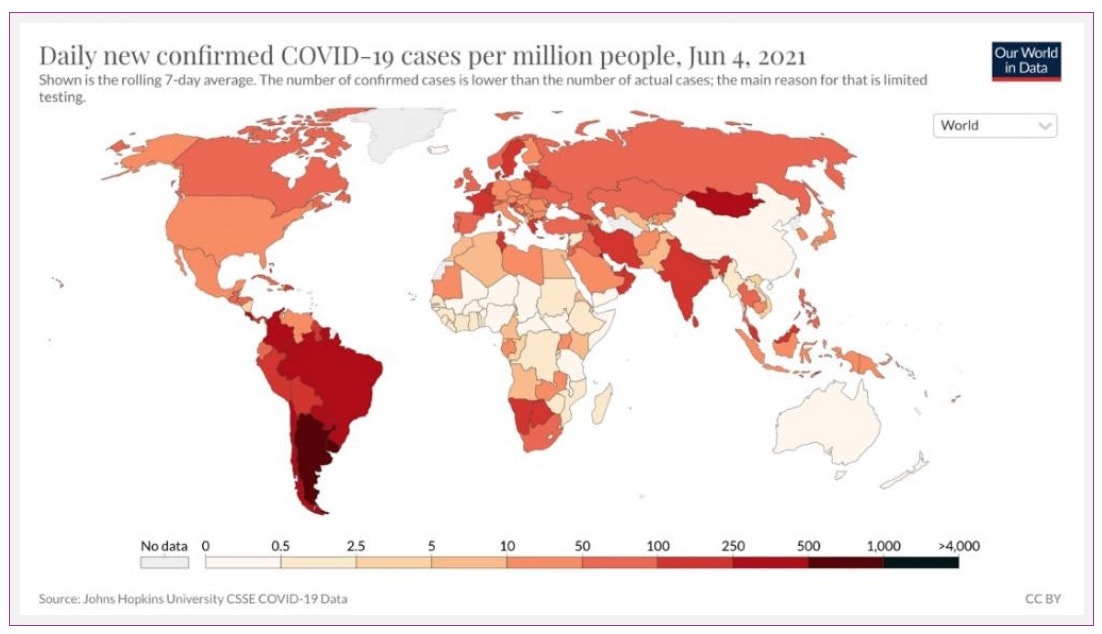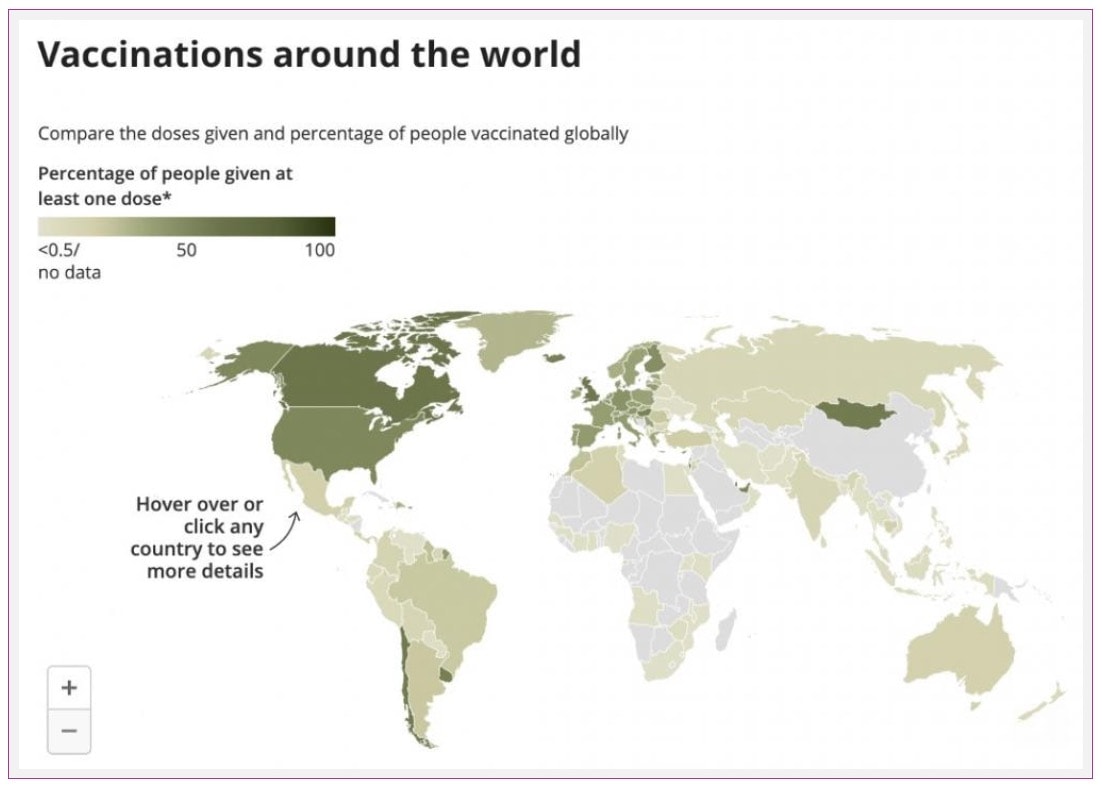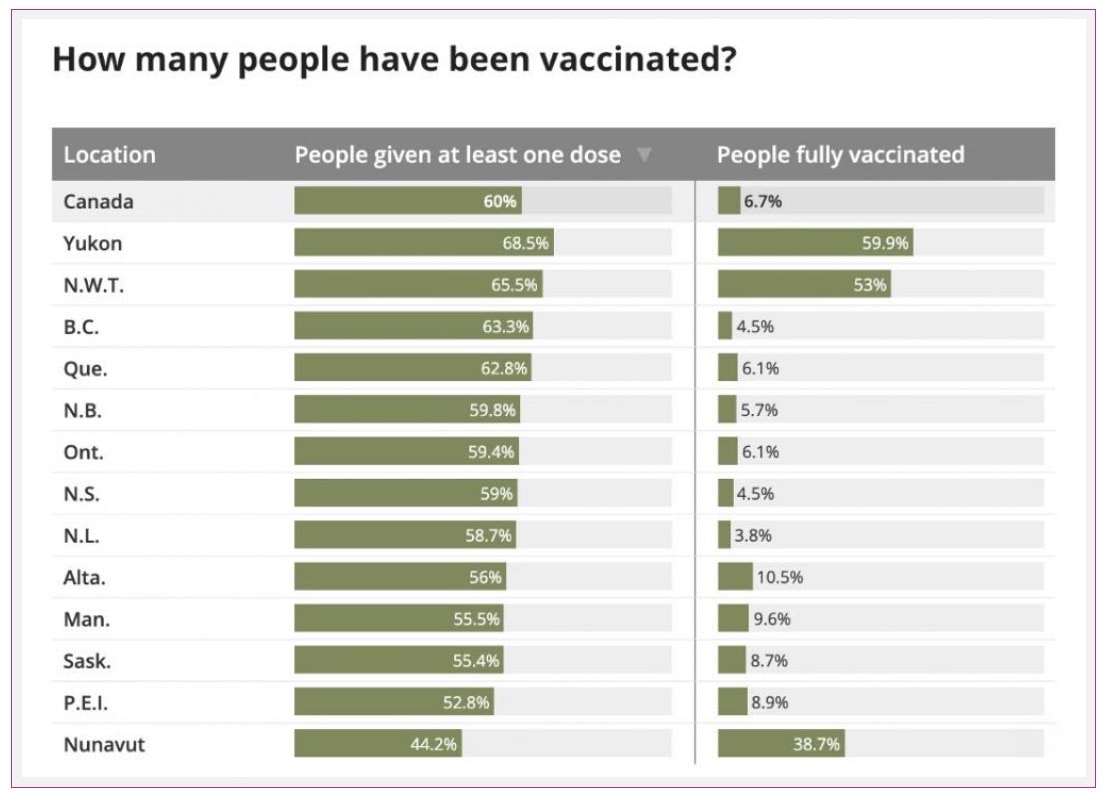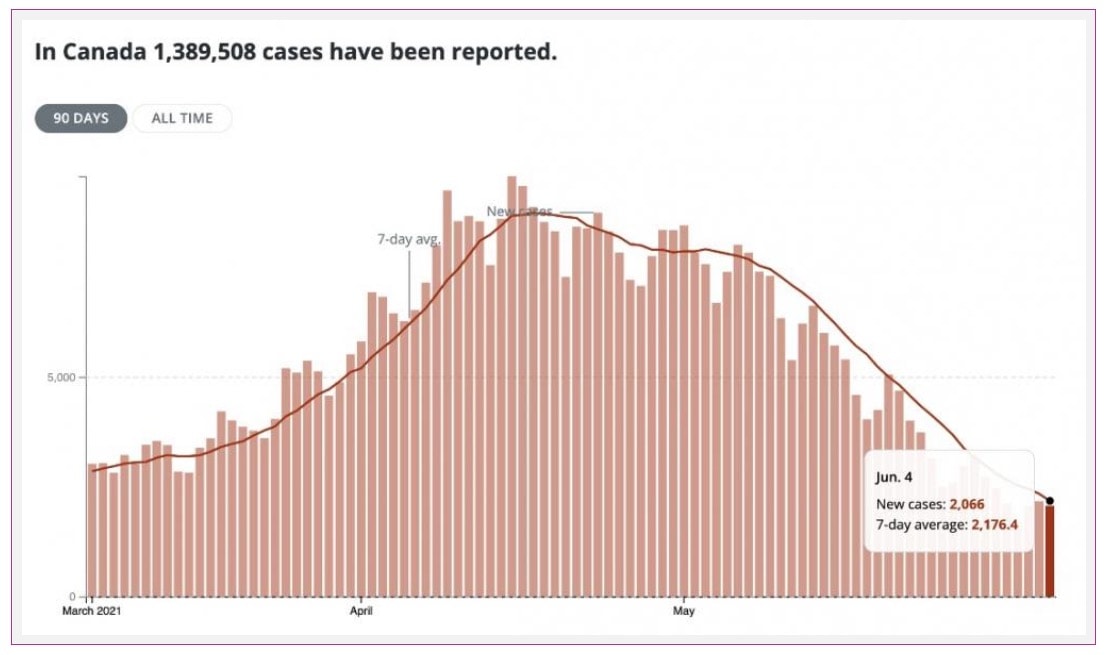More of your questions answered on COVID-19 vaccines!
Well, hello, friends!
I hope you had a healthy and safe weekend in the heat and sun. Welcome to our 32nd COVID-19 update.
As we do each week, we will review the bad news, followed by the good news, some common questions of the week, and my silver lining.
The bad news
Over 172 million cases of COVID-19 were reported around the world, with more than 3.7 million deaths, likely a gross underestimate. Those numbers are shocking to me each week.
Many areas of the world are seeing case numbers, hospitalizations, and death decrease, but there are several areas with soaring numbers, such as India and much of South America.

In Canada, we have reported almost 1.4 million cases of COVID-19, with over 25,000 deaths.
Though many millions of doses of the COVID-19 vaccines have been given worldwide, you can see how varied the distribution is.

Ontario families found out this week that our kids will not be heading back to in-person learning this school year. To say this was a sucker punch to parents, educators, the science community, and healthcare providers is an understatement.
I spoke in the media several times this week about the topic:
Should kids be in school? [on CTV News] [on CP24 News]
All I can say is, it sucks. I know many of your kids are struggling, and you are struggling. At least the Summer seems well and truly here, and we can spend more time outside, even when learning from screens all day.
Dr. Dina, what’s the good news?
More than 25 million COVID-19 vaccine doses have been given across Canada. We are due to receive 2 million more Pfizer doses each week until the end of August. This is encouraging as we try to get more first and second doses into citizens.

Cases of COVID-19 continue to decrease pretty much across the country, save for Manitoba and parts of the East Coast.

Questions of the week
I was asked so many questions this week, so I have decided to address several in point form.
Mix and Match
- The National Advisory Committee on Immunization (NACI) has recommended that individuals who received a first AstraZeneca (AZ) dose may receive an mRNA vaccine (Pfizer or Moderna) for their second dose.
- Individuals who received the first dose of an mRNA vaccine may receive a different mRNA vaccine for their second dose.
- NACI recommends that people who received the first dose of Moderna be offered a second Moderna dose as their second vaccine, and if the first dose was Pfizer, they should be offered a second Pfizer.
- But if the same mRNA vaccine is not readily available, another mRNA vaccine can be interchanged to complete the vaccine series.
- Evidence suggests that a first AZ dose followed by an mRNA dose is safe and will boost the immune response.
- There seems to be an increased rate of mild side effects when using a mixed vaccine schedule, such as fever, achiness, and local skin reactions.
- These are typical side effects from the COVID-19 vaccines and are temporary.
- There does not appear to be an increased risk of vaccine complications when we mix vaccine types.
- The second vaccine will be recommended 12 weeks after the first.
Should we be worried about the risk of a second AZ dose?
- The rate of Vaccine-Induced Thrombotic Thrombocytopenia (VITT) from a second AstraZeneca (AZ) dose is ~ 1/600,000.
- By contrast, the rate of VITT after the first dose of AZ is approximately 1/55,000.
- As the risk of developing VITT is rare, individuals who received a first AZ vaccine are encouraged to discuss receiving a second with their healthcare provider.
- The option is available to receive an mRNA vaccine as the second dose for those who wish.
Myocarditis and Pericarditis Following an mRNA Vaccine
- There have been reports of myocarditis and pericarditis (inflammation of the heart muscle or muscle lining) following mRNA COVID-19 vaccination.
- This is under investigation; however, no clear causation has been established between the vaccines and the illnesses.
Here is what we know so far:
- Cases of myocarditis and pericarditis have been reported in the U.S and Israel;
- Cases were more common after the second dose;
- People became symptomatic a few days after vaccination;
- Cases mainly were in young adults and adolescents and more common in males than females;
- Patients experienced mild illness and responded to rest and conservative treatment, and symptoms improved quickly;
- No significant illness requiring intensive therapy or ICU has been reported;
- The benefits of vaccination currently outweigh the risks, as mRNA vaccines prevent severe illness and death from COVID-19.
How to identify Myocarditis and Pericarditis
If you have recently received an mRNA vaccine and have any of these symptoms, please go to the emergency room:
- Chest pain
- Palpitations
- Shortness of breath
Investigations include an electrocardiogram (ECG), echocardiogram (ECHO), and blood work, including troponins.
Kids 12 and Older Can Get the COVID-19 Vaccine
Almost 50% of Toronto kids 12-17 years of age have received their first dose of a COVID-19 vaccine. This is huge!
Everyone 12 and older is eligible now, and more people are now eligible to receive their second dose, including:
- People 80 years of age and older
- Those who are 12 weeks post their first AZ dose
- High-risk healthcare workers
I answer more of your “kid vaccine” questions here:
What Do We Know About the Kid Vaccine for COVID-19?
What is with the new labeling of COVID-19 variants?
The World Health Organization (WHO) is now using the Greek alphabet to label variants of interest and variants of concern. This new system will be easier to remember and less stigmatizing. Strains will still have their scientific designations but will have additional Greek alphabet labels. For example, B.1.1.7, which originated in the U.K, is now called ‘alpha’.
You may have heard of the new ‘delta’ strain. This strain is B.1.617 and was initially documented in India. There is concern it will become the dominant strain in Canada and may lead to a fourth COVID-19 wave. Per the World Health Organization this week, ‘We continue to observe significantly increased transmissibility and a growing number of countries reporting outbreaks associated with this variant”. Fingers crossed.
My silver lining of the week
After the shock of our kids continuing to be stuck at home for the remainder of the year sunk in, I realized we have no choice but to see the bright side. I have genuinely enjoyed hanging out with our kids so much this year. I love seeing them when I leave for work and being greeted on my return. I love that they get to spend so much time with one another, and I love the focus on family and togetherness. Sure, we are sometimes crawling the walls and are eager for time apart and our own space, but with the nicer weather, we have an opportunity to spread out and get all our nervous energy out.
We have spent so much time running and cycling, playing tag and soccer, and just being outside. I feel like my gas tank is replenished each time we spend time outdoors in the sun. I took nice weather and outdoor spaces for granted before. I hope I never do again.
That’s all, friends.
I hope that was informative and helps you on your day-to-day journey.
I appreciate your messages of thanks and appreciation each week for these newsletters and education on Instagram every day. I am so happy to help!
Have a great week!


![[Dr. Dina News] IMPORTANT UPDATE re. VIRTUAL CARE](https://drdina.ca/wp-content/uploads/2021/01/dr-dina-kulik-kids-and-virtual-care-1a-400x250.jpg)
![[Dr. Dina News] COVID-19 Vaccine for Infants and Young Children.](https://drdina.ca/wp-content/uploads/2021/04/dr-dina-kulik-kids-and-vaccines-400x250.jpg)
![[Dr. Dina News] COVID-19 Vaccine for Infants and Young Children.](https://drdina.ca/wp-content/uploads/2022/04/DRD-1-400x250.jpg)






